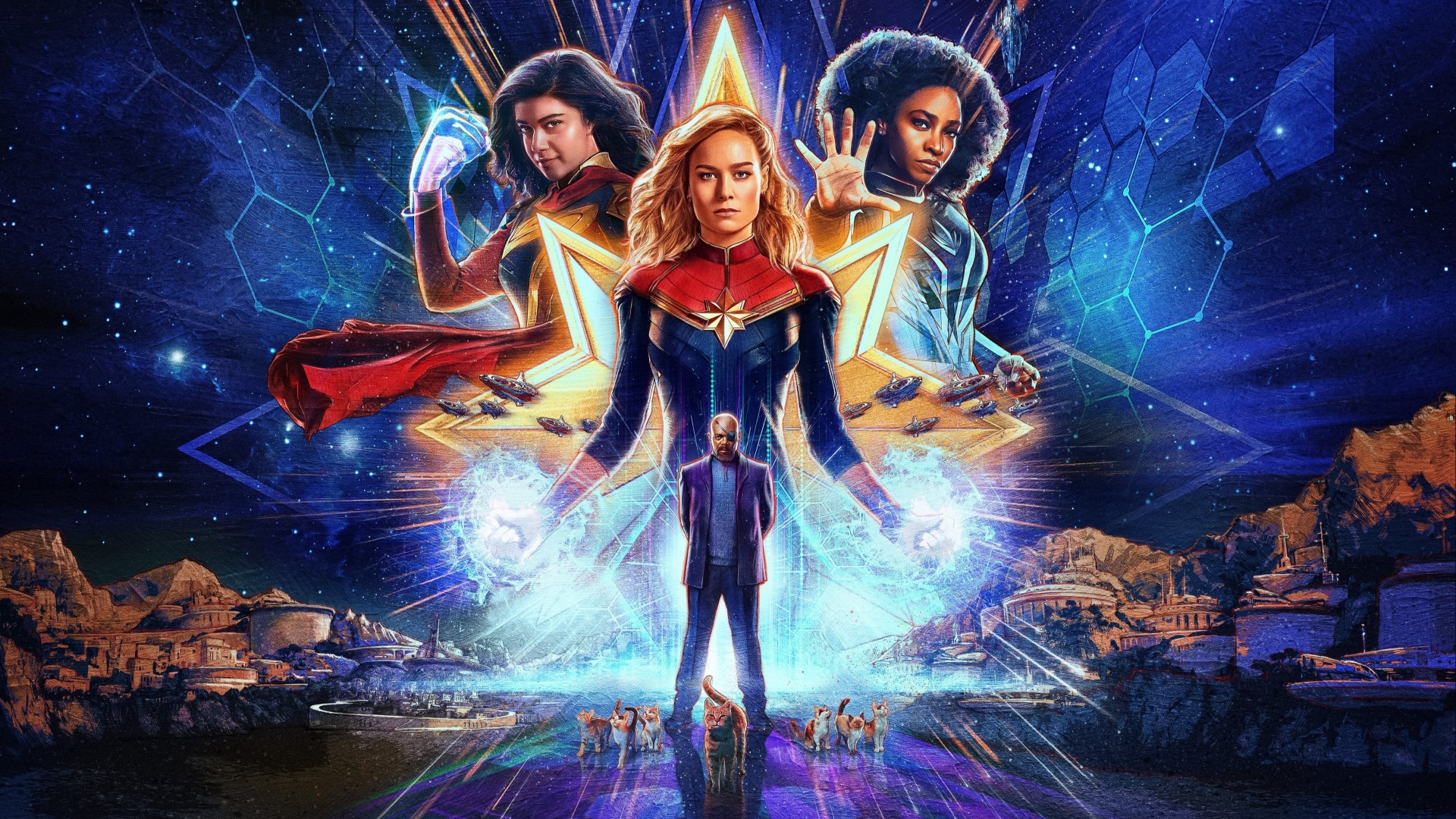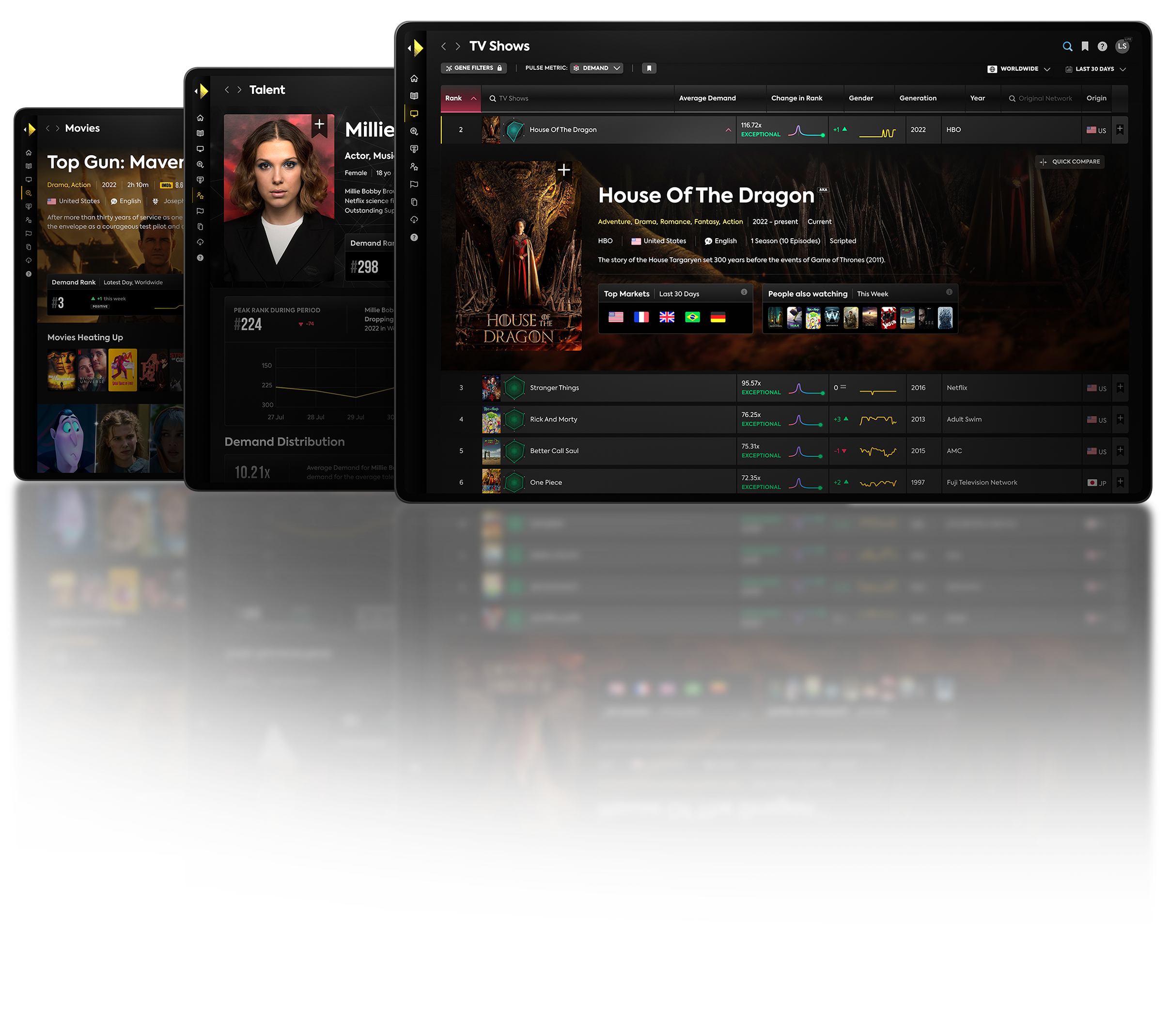Image: The Marvels, DIsney+
It is only natural that market-leading success eventually begins to wane and diminish as no studio or genre can remain dominantly unopposed forever in a Hollywood life cycle. As a result, Marvel Studios is currently at the epicenter of the entertainment industry’s concern regarding the superhero genre. That’s simply unavoidable as The Marvels delivers what is expected to be the Marvel Cinematic Universe’s (MCU) lowest-grossing film in its 15 year history. Yet exploring the MCU’s recent wobbles more in-depth may help identify what tweaks can be made moving forward to reinvigorate audience demand in the genre.
From Q1 2022 to Q3 2023, MCU content (both TV series and movies) has accounted for a low of 17.9% of Disney+’s total catalog demand (i.e. all available titles) and a high of 19.8%, reflecting strong consistency. Zooming in on the MCU’s contribution to Disney+’s total catalog demand, the franchise’s movies tend to account for between a 20%-23% quarterly demand share while the TV shows range from 10%-16%, according to Parrot Analytics. Since the silver screen elicits more demand from audiences than its small screen siblings, we’ll start with movies.
“Superhero fatigue? It’s more like lukewarm movie fatigue,” Paul Dergarabedian, senior media analyst at Comscore, said. “Marvel has become a victim of their own success as they’re now held to such a high level. Any product, brand, movie or franchise that's around for years is going to see some rough patches. I would never count out Marvel, but they definitely need to right the ship.”
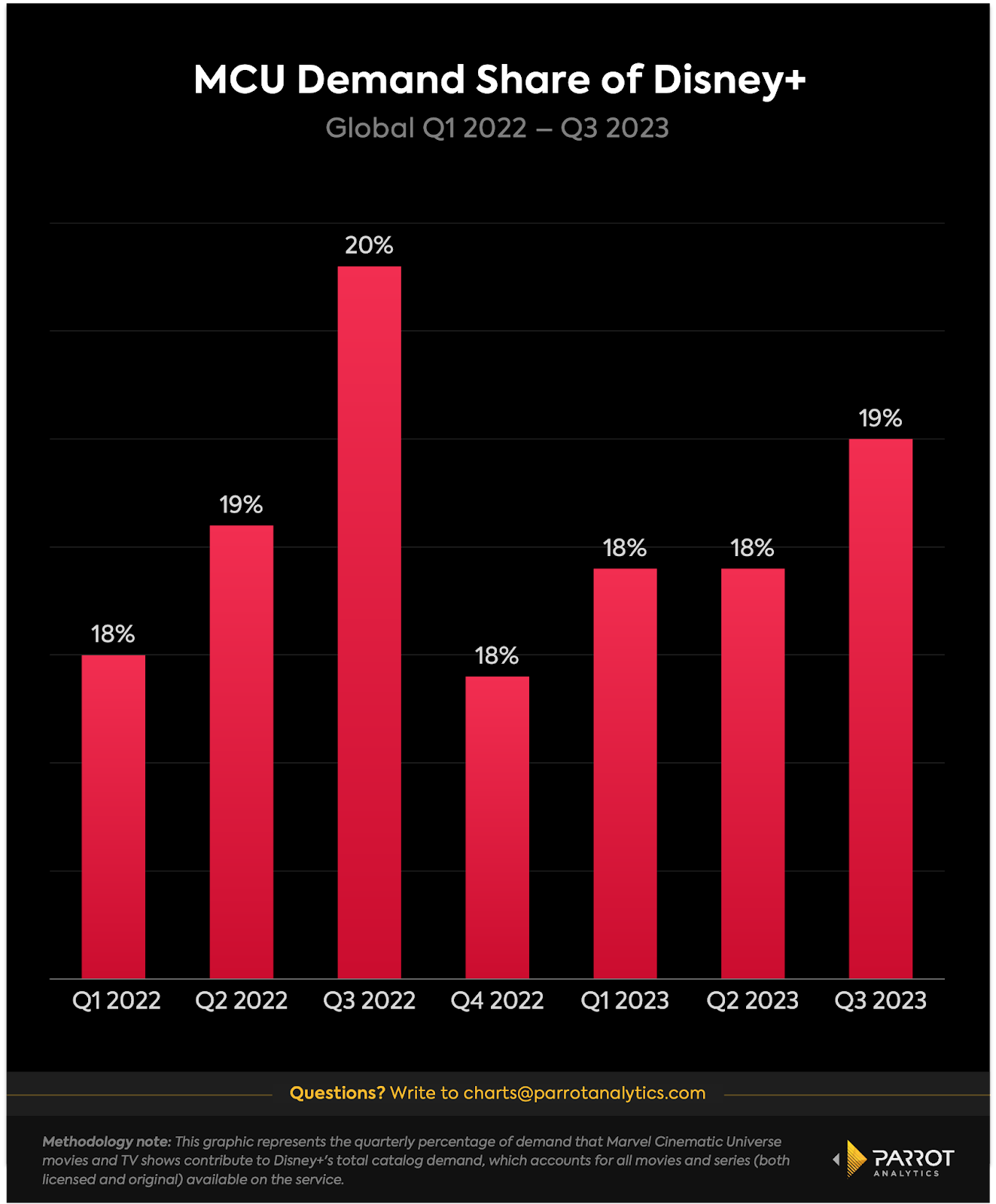
MCU Movies
Based on critical and commercial reception, it should come as no surprise that Marvel is seeing somewhat diminishing returns from its films. Beginning with Guardians of the Galaxy Vol. 2, when Parrot Analytics’ movie demand data begins, the worldwide average demand of Phase 3 movies (which spanned 2016-2019) in their first month of release was 159.10x. In other words, Phase 3 movies tended to be 159.10 times more in-demand than the average movie worldwide in their first four weeks when averaged together. In Phase 4 (2021-2022), this declined by 20% and while we only have a full month of data for two Phase 5 films, this number has again fallen by 8% compared to Phase 4 thus far.
Naturally, a resetting of expectations was needed after the unprecedented success of Avengers: Endgame, which served as the culmination of a decade of big screen storytelling. As the MCU shifted away from the core original Avengers such as Iron Man, Steve Rogers’ Captain America and Black Widow and began introducing new-to-screen characters, there was always going to be something of a drop off. Not every movie can be a universally beloved $1 billion smash hit.
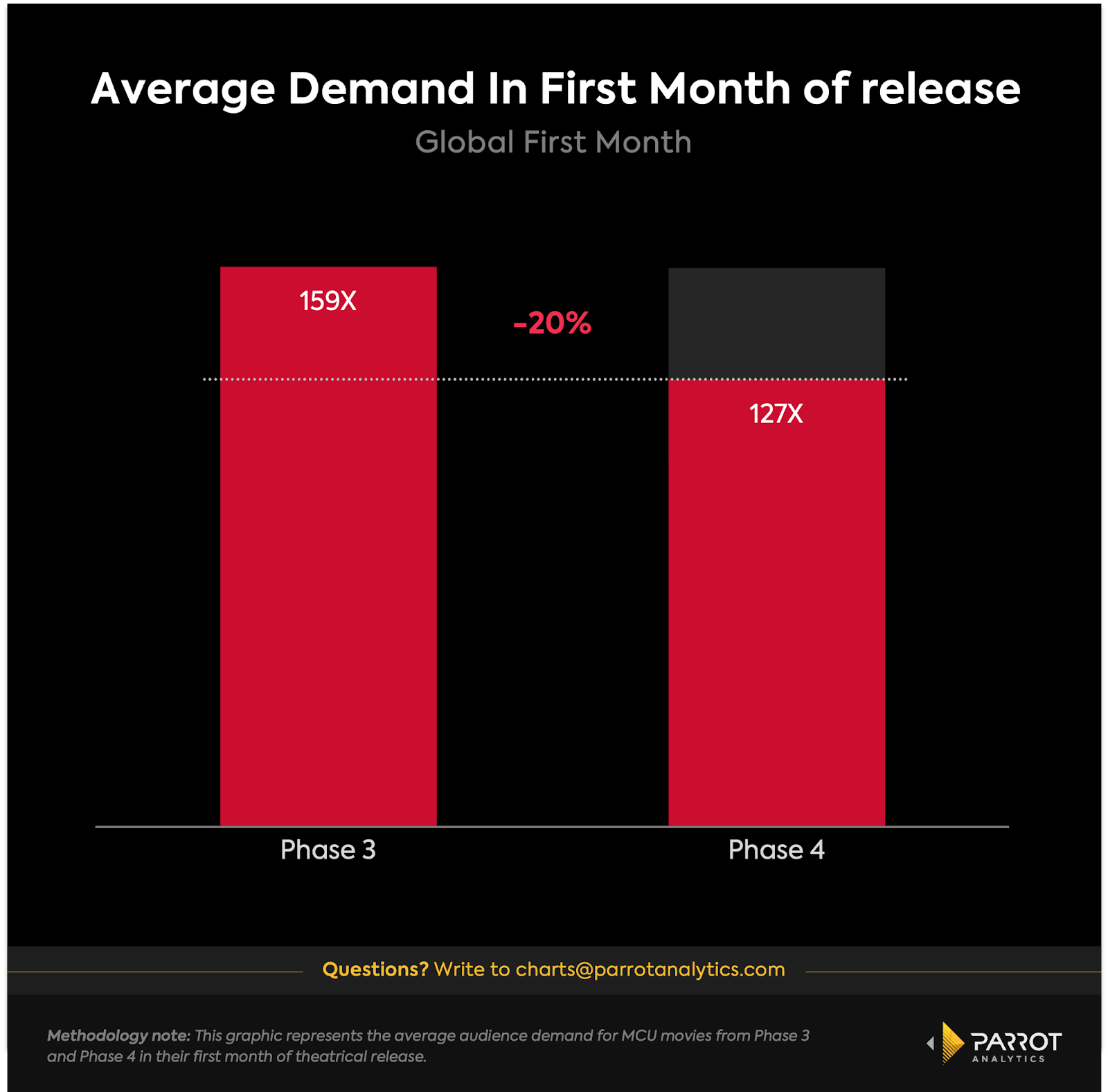
Yet market conditions and internal ambitions would collide to create new shifts within the MCU and, as a result, impact audience behavior. As Disney worked tirelessly to fuel Disney+’s early growth, the pandemic arrived to significantly hamper the theatrical industry and keep audiences at home for extended stretches. In response, Disney experimented with hybrid releases — Black Widow was released in theaters and for an additional up-charge on Disney+ simultaneously — and shorter theatrical windows in the early portion of Phase 4. At the same time, Disney+ was delivering a constant barrage of new and exclusive MCU shows (nine since 2021 began). Both these elements worked to train audiences to expect blockbuster superhero fare readily available at home and arguably de-emphasize the special event nature of new MCU films.
Given the front-loaded nature of tentpole box office earnings, this arguably hurts initial theatrical interest in films with more mixed word of mouth. Why go out for a special trip to the theaters when you can watch the same film for “free” at home in the relatively near future? Fair or not, The Marvels (61% on Rotten Tomatoes) and Eternals (47%) currently have two of the six lowest opening box office weekends in the MCU.
These shifts also contributed to a difference in mediums. Phase 3 movies routinely saw worldwide audience demand in the first month of streaming availability drop anywhere between 45% and 87% compared to their first month in theaters, suggesting theatrical held a strong priority over streaming. Phase 4 saw declines under 30% and even saw increases for Shang-Chi and the Legend of the Ten Rings (+ 11%) and Eternals (+ 17%) in the initial streaming window (potentially due to a combination of the pandemic, shorter theatrical windows and perceived quality). Thus far through Phase 5, Ant-Man and the Wasp: Quantumania (-34%) and Guardians of the Galaxy Vol. 3 (-41%) are generally performing better at home than most Phase 3 movies as well (the former is considered one of the MCU’s most glaring theatrical misses).
Even as Disney has returned to more standard exclusive theatrical windows of at least 80 days, retraining audiences to prioritize the theatrical experience may take more time. Though several MCU films have been very financially successful since Endgame, only Spider-Man: No Way Home, which is owned by Sony Pictures, has crossed $1 billion since 2020. The most successful new big screen MCU character introduction across the last two phases is likely Shang-Chi. The film was largely a standalone story that brought new cultural influences and action styles to the franchise while delving deeper into the only lightly unexplored mystical corner of the comic book universe.
But the seamlessly integrated building blocks of the Infinity Saga — introducing characters, plot elements and MacGuffins that revolve around the overarching goal of a single villain — have not translated to the Multiverse Saga. Instead, much of these recent phases have revolved around death, grief and moving on in a world without many of the original Avengers which has made for some artful yet somber experiences. Audiences have been waiting for new characters and story beats to converge around a still nebulous central villain in Kang (played by Jonathan Majors, who is facing legal issues related to assault allegations). It’s not yet clear how the events of certain Phase 4 and Phase 5 titles connect with or impact one another while remaining distinct.
MCU TV
On the television side, it’s been a mixed bag. Unsurprisingly, the average worldwide demand for MCU Disney+ series seasons featuring established legacy characters (WandaVision, The Falcon and the Winter Soldier, Loki Seasons 1-2, What If Season 1, Hawkeye and Secret Invasion) is 21% higher than MCU Disney+ series featuring new-to-screen characters (Moon Knight, Ms. Marvel, She-Hulk: Attorney at Law). That’s to be expected.
What’s more concerning is the relatively steady decline in reach, which Parrot Analytics uses to indicate the breadth of a title’s popularity as it represents the total number of unique users expressing demand for a title, across the Disney+ shows.
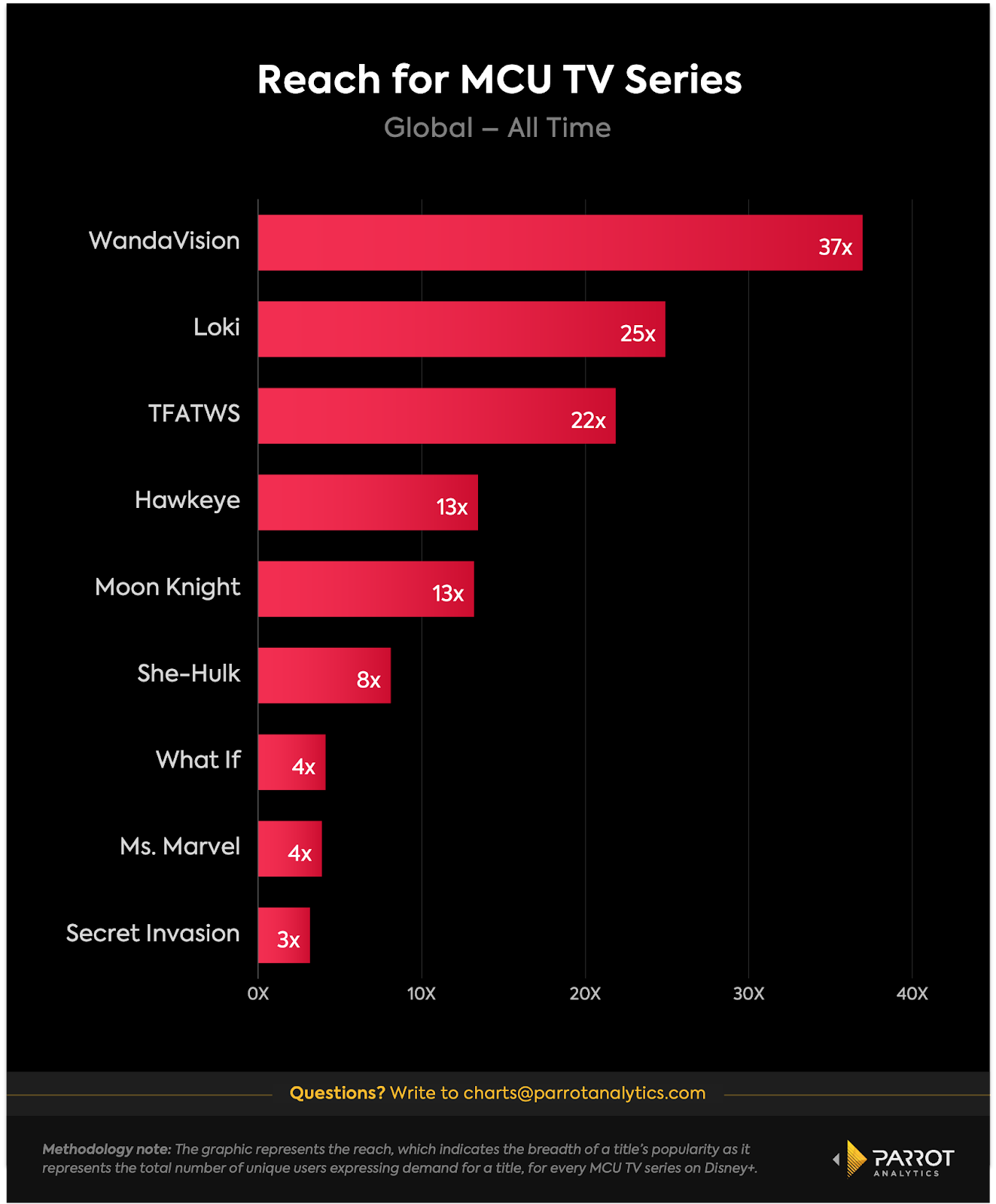
This reach trend suggests that the MCU reached saturation — as in, Disney hit a ceiling in terms of everyone who was interested in Marvel shows — and then potentially spilled over into over-saturation — or flooding the market with too much product that didn’t consistently meet audience expectations to the point that some Marvel fans began tuning out. Disney CEO Bob Iger recently hinted at reducing the MCU’s annual output moving forward.
“At the time the pandemic hit, we were leaning into a huge increase in how much we were making,” Iger said during Disney’s earnings call in November. “And I’ve always felt that quantity can be actually a negative when it comes to quality, and I think that’s exactly what happened. We lost some focus.”
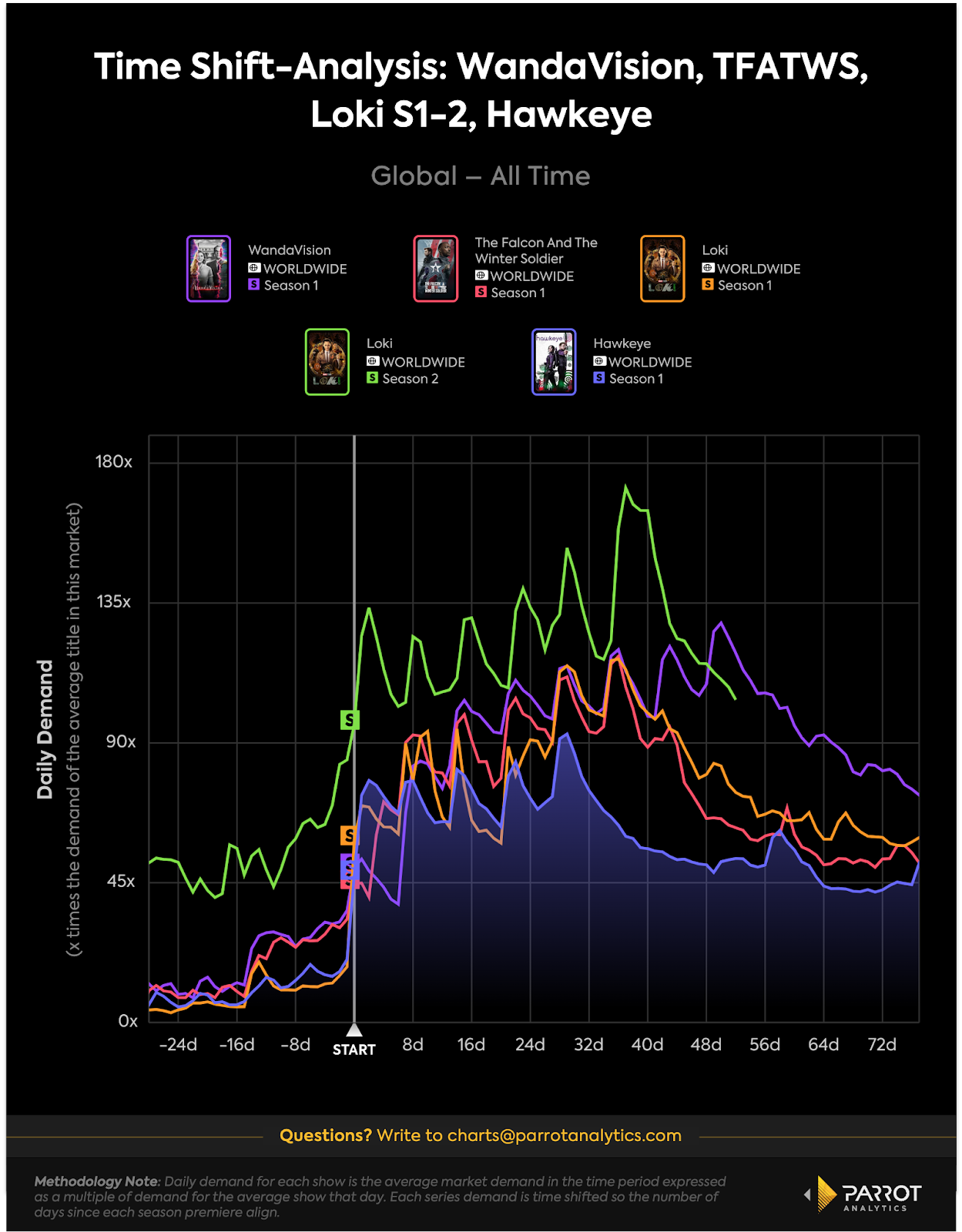
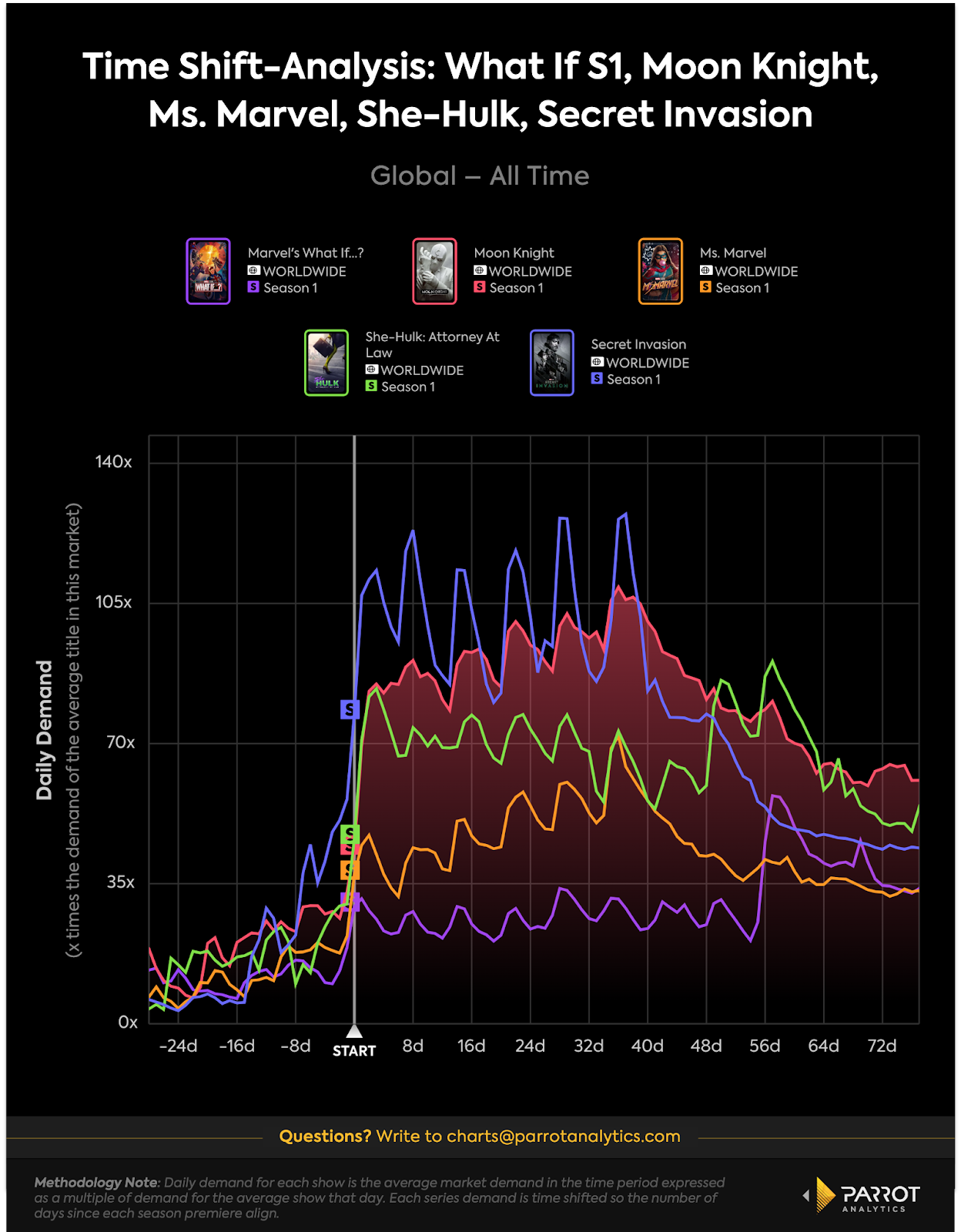
Moon Knight, which averaged 89.40x more demand than the average TV series worldwide during its run, is one of the more successful new MCU TV character series despite its somewhat divisive reception. This is likely due to its exceptional travelability (36.9x), which indicates the popularity of a show outside of its home market, which can be partially attributed to its multi-cultural influences and exploration of the spiritual. Similar to Shang-Chi, expanding who is represented on screen and where superhero abilities and mythology originates tends to help open doors to new audiences. Fresh takes on well-worn genres help prevent them from growing stale if its backed by quality storytelling.
Yet the MCU’s interconnected storytelling, which initially sparkled as the franchise’s greatest asset, may have become cumbersome for the average fan who can’t or won’t dedicate the hours necessary to stay up to date. The Marvels currently stars two MCU TV characters (and somewhat follows the aftermath of Secret Invasion) alongside Brie Larson’s Carol Danvers. Casual observers who aren’t familiar with the shows might be less interested in the big screen team up. There’s a reason Marvel is setting up a “Spotlight” brand for Disney+ series that are largely standalone within the MCU. Striking a balance between interconnected and self-contained is key.
MCU Future
In just 15 years, this franchise has delivered 33 movies, nine TV shows and grossed nearly $30 billion in box office revenue while helping Disney+ accrue 150 million worldwide subscribers. Even if the superhero genre is slowing to an extent, such dominance will not plummet overnight just because the franchise hit its first stretch of turbulence in recent years.
In 2024, Marvel is set to release what is expected to be its first R-rated film in the third Deadpool movie, which will bring Hugh Jackman back as Wolverine. In 2025, it will be followed by the anticipated reboot of the Fantastic Four while seeds for the X-Men have already been planted across Ms. Marvel, Wakanda Forever and The Marvels.
How Disney and Marvel Studios handle these potentially blue chip titles will help provide clarity into the health and longevity of the Marvel Cinematic Universe.
